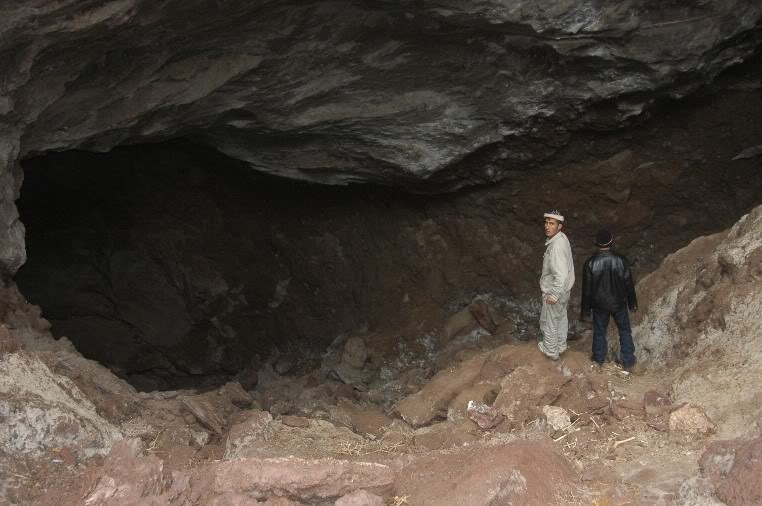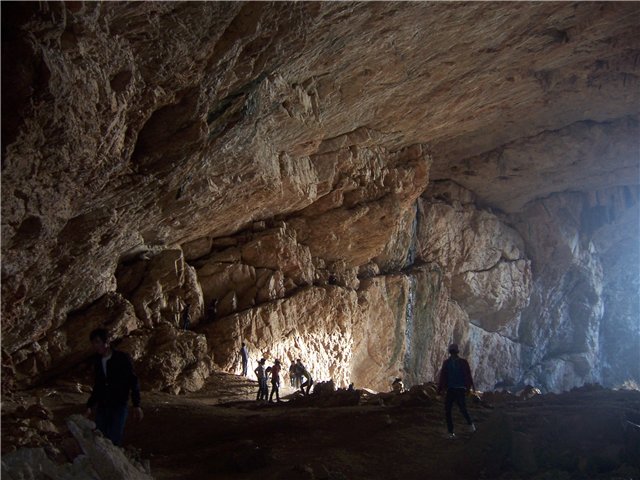
Salt-mountain Khoja Mumin is located in southern Tajikistan, 25 kilometers in the southwest of Kulyab. Khoja Mumin has a shape resembling a giant dome towering 900 m above surrounding plain (absolute height 1332 m). It stays visible for tens of kilometers. Because of the white salt of which the mountain is composed, it seems that the mountain is freshly covered with snow. The length of the mountain in diameter reaches 8.5 km. Together with the neighboring ridge Khoja Sartis, they belong to the largest diapirs in the world. Similar salt mountain exist in southern Iran, named Kuhi Namak. There are also known salt masses in Palestine and on the Arabian Peninsula.
The slopes by the mountain foot are steep and the height of exposed salt walls reaches 500 m. The formation of the salt stratum occurred in the second half of Mesozoic era in late Jurassic era.
There are many sinkholes on the slopes of the massif. They reach in diameter 200 m. Many sinkholes are in the form of vertical wells or air trunks with black holes. The abundance of salt caves makes it hard to calculate accurately. Among the known giant caves, it is worth noting a 1200 m long cave; The Great Circus. On the southeastern slope of the massif there is a large stalactite cave “Tiger spring”. At the entrance of the massif there formed small water reservoirs, holes, salt piles and other formations.
Inside the cave, there are narrow corridors and spacious halls up to tens of meters high. The air of the cave is saturated with salt. As a result, fantastic snow-white formations formed on the walls. Giant stalactites hang from the ceiling, and stalagmites grow on the cave floor. There are also gelectites, salt bouquets in the cave.
The caves of Mount Khoja Mumin are completely composed of salt stalactites and stalagmites. The height of halls of the largest caves reaches 8-10 meters. Many of the caves make music-like sounds produced by the wind blowing through stalactites and stalagmites. The caves emerged as a result of washing out from the interior of sodium chloride.
Since ancient times, local people have been extracting salt from the slopes of the mountains. The Khodja Mumin table salt deposit is one of the largest in the world. At the foot of a mountain was built “Khoja Mumin” plant, engaged in: production and processing of salt, providing local people with workplaces and salt, and maintaining a preventive clinic, where osmotic diseases are cured.
After rain, salt-saturated streams flow from mountain, giving rise to more than 160 salty streams. At the top of Khoja Mumin there are bodies of fresh water. Thanks to fresh water, numerous herbs and flowers grow on a salt cap. In the spring, the peak of Khoja Mumin is covered with a bright red carpet of blooming tulips.
It is little known about caves of the salty mountain. It is only mentioned about caves in written reports of geologists. Last cavers visited caves of the salty mountain at the end of the 20th century.
Tajikistan has never fostered its own cavers. Kyrgyz cavers were in Khoja Mumin in 1988. We explored several caves that left very vivid memories of the salt karst of Khoja Mumin.
We invite all international caver groups, clubs, associations to take part in the expedition to Tajikistan in September 2020.





